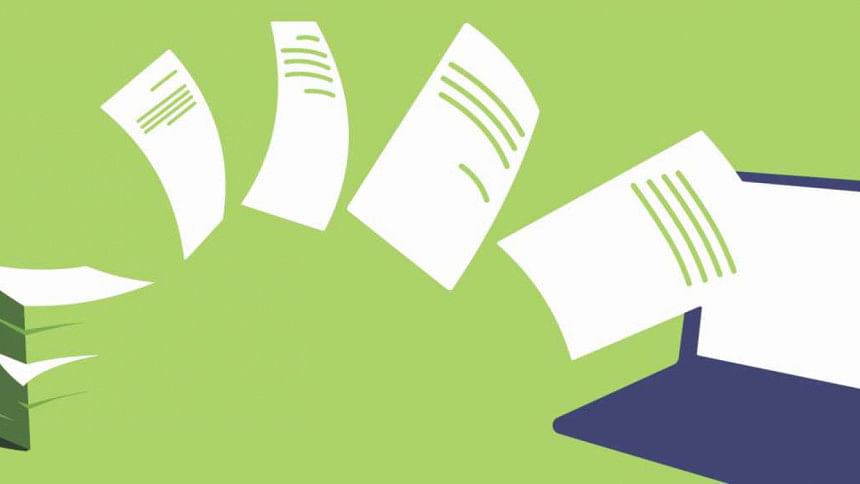The Virtual Vogue

By habit, I shake the morning newspapers violently every morning. This way, I shake redundance off the pages. Most mercilessly, I call the promotional materials "redundant". How many of us actually take time to flip through the glossy prints that promise us a run to the rainbow? Very few, actually. So, while the glossy A4 size "look-at-me" slips through my fingers at 7:30 am everyday, I feel liberated. The noise of the crisp pages dropping to the floor helps me realise that we don't need paper as much as we think we do.
True, a desk calendar is hard to resist; a small notebook for appointment is difficult to do without and a moleskin is to die for. Yet, hasn't a cell phone replaced them all? We have our lives sculpted into our phones. Mails, appointments, to-do lists, reminders, alarms, clocks, photos, notes . . . everything. Photo albums are getting to be a thing of the past. Watches are occupying more of a vain social space where the wealthy show off their "jumma time" in social media every Friday while sharing their latest acquisition. Diaries, unless initialled and inscribed, are a pre-historic possession. A cell has it all.
The most terrifying part is having a cell talking to you. A digital assistant called Siri is playful. In the middle of huge Dha-ffic (Dhaka traffic) jams, Siri can be superbly entertaining with the programmed responses to questions. Very soon, without us fully realising, we will be speaking to robots. (My son already has a robot cleaning his house). Get used to it. Artificial intelligence is taking over our lives. Science fiction is becoming dangerously closer to reality. And we are tip-toeing to virtual existence, increasingly becoming dependent on digital temptations. One can't read news without ads popping up in the net, one can't have full access to a piece of news without signing up ensuring that the news portal, the website or the entertainment site has full access to the pattern of our desire and taste. If one looks for a hotel somewhere, the next day one is sure to be flooded with mails from different sites offering "top ten things to do" in that specific area. If , in case, one shop somewhere are bound to sign up, one is certainly and unfailingly going to receive hundreds of offers within the next seven days from different vendors who "sense" personal shopping tastes. That's it. The virtual is sensing us. Tactile is over.
A few years ago, a sleek object landed up on our laps, offering virtual freedom to bookshelves. The object is none other than a Kindle. Thanks to the Apple/I-trappings, many of us read books on Kindle.
It's easily downloadable and saves space. But I still have many friends who complain about not being able to read in a digital object. Many of them prefer the relatively cheap paperbacks while my literary snobbish friends stick to the first out hardcover. I opt for none. For me, Kindle is kind to my spondylitis, my fibromyalgia and my storage. Neither do I have to stuff a fat 600 paged book into my bag, nor do I ask the house help to clean the shelves as much as we used to anymore. This is exactly how spaces have become irrelevant and this is how the virtual is in vogue now.
Once upon a time, one would gloat about efficiency by measuring the towering files on a desk. Times have changed. One boasts of being paperless today. Every year, the world produces more than 300 million tonnes of paper with copier paper, computer printouts and notepads occupying the largest category of paper product consumption. Today, the usage of paper products has increased from 92 million tonnes to 208 million, which is a growth of 126 percent over the last 20 years. But unfortunately, globally, 45 percent of the paper printed in offices ends up in the bin by the end of the day. And the ones to remain, end up in expensive cabinets. For example, each four-drawer file cabinet holds an average of 10,000 to 12,000 documents, takes up to 9 square feet of floor space. But fortunately, an Asian has lesser to be blamed for as an average Asian consumes six times less paper than an American who uses more than 318 kilograms of paper every year.
Pulp and paper industry, accounting for 4 percent of the global energy use, is the fifth largest consumer of energy and over 60 percent of the roughly 17 billion cubic feet of timber harvested worldwide each year is used for paper and pulp. The paper industry also uses more water in production than any other industry. We also lose around 18 million acres of forest each year, which equals a loss of 20 football fields every minute. In less than 100 years, we will be destroying all the rainforests on the earth. And in spite of our fashionable conversations about recycling, in reality, paper cannot be recycled indefinitely. After a max of ten times, the fibres break down.
Yet . . . the paper in the average business grows by 22 percent a year and paper consumption has risen by 400 percent in the last 40 years.
At our end, let us also remind ourselves that we don't need to send greeting cards on every occasion. With a Happy New Year greeting card in December and January, with a Pahela Baishakh one in April, with Eid Mubaraks twice a year, with wall calendars and of course the endless coloured paper flyers crowding our desks (no offence meant), along with the layered, expensive boxes that come as wedding invitations which end up being trashed in the bin almost immediately after they are received and recorded in the appointment log, needn't we ask ourselves if at all, any of this is necessary? And if there's any way of doing this all paperlessly?
So, this is how we go on, gradually treading from our "paperful" existence to a paperless one. At the end of it all, all we want is a clutter free life, space and spirit, don't we?
The writer is Managing Director, Mohammadi Group.

 For all latest news, follow The Daily Star's Google News channel.
For all latest news, follow The Daily Star's Google News channel. 



Comments